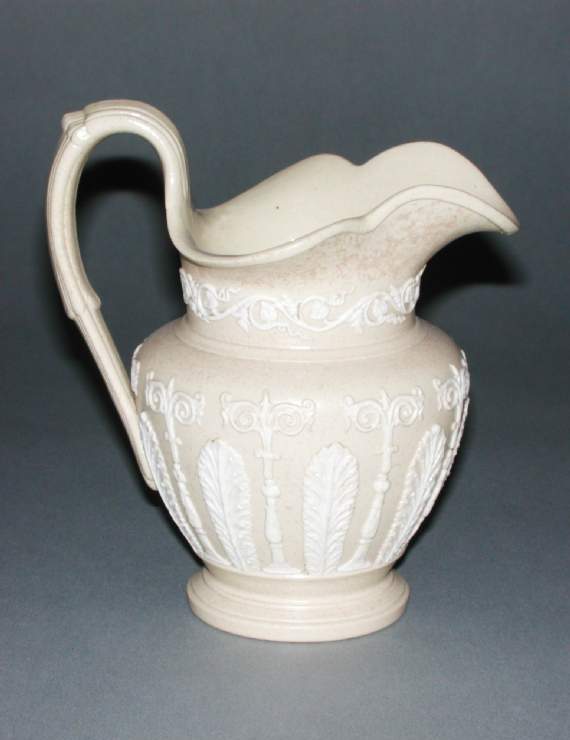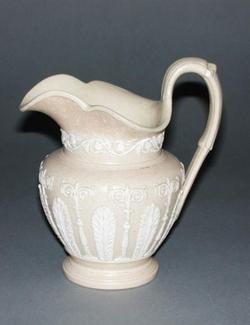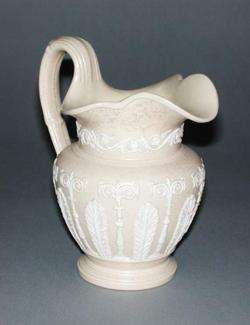Current Location: In storage
Maker(s)
Factory:
John Ridgway & Co.
(Probably)
Factory:
John and William Ridgway
(Perhaps)
Entities
Categories
Description
Small, pale buff stoneware jug, with applied white reliefs; smear-glazed.
Pale buff stoneware with white reliefs; smear-glazed. Urn shaped body standing on a small foot with wide neck, flaring and scalloped at the rim and lip. Neo-classical decoration of vertical, stylised leaves and 'candelabra' motifs, alternating around the body, and a band of scrolling foliage around the neck. The interior is fully glazed. The underside is flat, within a foot-ring.
Notes
History note: Unknown before A H Palmer
Legal notes
Bequeathed by A H Palmer
Measurements and weight
Height: 12.5 cm
Width: 11.5 cm
Acquisition and important dates
Method of acquisition: Bequeathed
(1985-01-28)
by
Palmer, A. H.
Dating
19th Century, Early
George IV
Circa
1820
CE
-
1830
CE
Note
Smear-glazed jugs were popular in 19th Century homes, where they were used for water, beer milk and other liquids which might now be kept in bottles, cans or plastic jars. The size and style of this example suggest it may be a milk jug. The smear-glazing makes the most of the way that colour-stained clays show off crisply-moulded ornament, here in contasting off-white sprigs, and the stoneware is sufficiently durable for everyday use. Sprigging, or designs formed in small plaster, clay or brass moulds and applied to leather hard clay, was a common form of decoration from the late eighteenth century. From around the mid 1820s, such jugs were more often made in two-piece relief moulds. There are several examples in the Fitzwilliam Collection.
The Ridgway family produced stoneware and china in Staffordshire from the 1790s until the 20th Century. The pad mark on this jug was used between c.1815-1830 when, trained by their father Job, the brothers William and John were known for producing this type of drab (coloured) stoneware decorated with applied relief sprigs. A Bell Works pattern book indicates that it was probably made there, though the brothers also operated at Cauldron Place Works and, in 1830, separated to run their own factories. The family were also noted philanthropists, William Ridgway built alms houses and a school for local children – many of whom he employed in his potteries.
School or Style
Neoclassical
Components of the work
Decoration
Materials used in production
Stoneware
Techniques used in production
Smear-glazing
Inscription or legends present
Inscription present: lozenge shaped pad with motifs, numerals within central oval shape
- Text: 292
- Location: On base
- Method of creation: Applied pad with impressed numeral
- Type: Mark
References and bibliographic entries
Identification numbers
Accession number: C.8-1985
Primary reference Number: 76173
Stable URI
Audit data
Created: Saturday 6 August 2011
Updated: Tuesday 30 April 2024
Last processed: Wednesday 10 December 2025
Associated departments & institutions
Owner or interested party:
The Fitzwilliam Museum
Associated department:
Applied Arts






